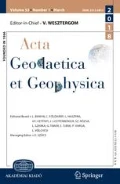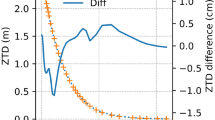Abstract
The ionospheric anomalies are often responsible for compromising the accuracy and performance of Global Navigation Satellite System (GNSS). GPS Aided Geo Augmented Navigation (GAGAN) is the autonomous Space Based Augmentation System of India which serves to provide timely error detection and correction for the corrupted GNSS signals in aircrafts. This paper discusses a Maximum Minimum Eigen (MME) detector to identify the ionosphere induced errors in the GNSS signals. Data has been collected from 24 different GAGAN receivers spread over the length and breadth of India from January to December, 2015. The climatology of ionospheric anomaly over India, has been established using the MME detector. This paper discusses the spatio-temporal dependence of ionospheric anomalies over India. The observations indicate an increased ionospheric activity in the course of equinoxes and a comparitively quiet ionosphere in the course of solstices. A higher number of ionospheric disturbance incidents have been noticed closer to the anomaly crest. The results from the MME detector have been verified against the Rate of Total Electron Content (TEC) Index (ROTI) values and S4 observations for the year 2015 at the 24 GAGAN TEC stations. The disturbance climatology obtained from MME detector, ROTI and S4 exhibit a high correlation. However, the outcome of the MME detector clearly shows that it is capable of picking up even small irregularities in the ionospheric TEC.









Similar content being viewed by others

References
Acharya R, Majumdar S (2019) Statistical relation of scintillation index S4 with ionospheric irregularity index ROTI over Indian equatorial region. Adv Space Res 64(5):1019–1033
Acharya R, Nagori N, Jain N, Sunda S, Regar S, Sivaraman MR, Bandhopadhyay K (2007) Ionospheric studies for the implementation of GAGAN. Indian J Radio Space Phys 36(5):394–404
AIP Suppliment, 48/2013 (2013) Aeronautical Information Service, Airports Authority of India
Balsley BB (1969) Night time electric fields and vertical ıonospheric drifts near the magnetic equator. J Geophys Res Space Phys 74(5):1213–1217
Bishop G, Howell D, Cocker C, Mazzella A, Jacobs D, Fremouw E, Secan J, Rahn B, Curtis C, Quinn J, Groves K, Basu S, Smithan M (1998) Test bed for evaluation of GPS receivers’ performance in ıonospheric scintillation-a progress report. İn: Procedings of ION national technical meeting, Long Beach, pp 637–648
Dammalage T, De Silva DN, Satirapod C (2017) Performance analysis of GPS aided geo augmented navigation (GAGAN) Over Sri Lanka. Eng J 21(5):305–314
Deshpande MR, Sethia G, Rastogi RG (1978) Geomagnetic storm effects on ıonospheric total electron content in ındian zone. Indian J Radio Space Phys 7(2):111–118
Doherty PH, Delay SH, Valladares CE, Klobuchar JA (2000) Ionospheric scintillation effects in the equatorial and auroral regions. İn: Proceedings of the 13th ınternational technical meeting of the satellite division of the Institute of Navigation (ION GPS 2000), vol 50, Salt Lake City, pp 662–671
Grski A, Gerten G (2007) Do we need augmentation systems? Eur J Navig 5(4):2–8
Jacobsen KS (2014) The impact of different sampling rates and calculation time intervals on ROTI values. J Space Weather Space Clim 4(A33):1–9
Jacobsen KS, Andalsvik YL (2016) Overview of the2015 St. Patrick’s day storm and its consequences for RTK and PPP positioning in Norway. J Space Weather Space Clim 6(A9):1–12
Knight M, Finn A (1996) The ımpact of ıonospheric scintillations on GPS performance. İn Proceedings of the 9th ınternational technical meeting of the satellite division of the ınstitute of navigation (ION GPS 1996), Kansas City, pp 555–564
Liu Yang, Lianjie Fu, Wang Jinling, Zhang Chunxi (2018) Studying ıonosphere responses to a geomagnetic storm in June 2015 with multi-constellation observations. Remote Sens 10(5):1–20
Mojalefa Moeketsi D (2007) Solar cycle effects on GNSS-derived ionospheric total electron content observed over southern Africa. Rhodes University, Eastern Cape, Ph.D. Thesis, Dec 2007
Nichols J, Hansen A, Walter T, Enge P (2000) High-latitude measurements of ıonospheric scintillation using NSTB. J Inst Navig 47(2):112–120
Pi X (2018) The rate of TEC ındex and global ıonospheric ırregularity map. İn: 42nd COSPAR scientific assembly, Pasadena, California, 14–22 July 2018, pp 1–10
Raghunath S, Venkata Ratnam D (2015) Detection of low-latitude ionospheric irregularities from GNSS observations. IEEE J Sel Top Appl Earth Observations Remote Sens 8(11):5171–5176
Raghunath S, Venkata Ratnam D (2017) Maximum–minimum eigen detector for ıonospheric ırregularities over low-latitude region. IEEE Geosci Remote Sens Lett 14(6):901–905
RG Rastogi, VL Patel (1975) Effect of ınterplanetary magnetic field on ionosphere over the magnetic equator. In: Proceedings of the Indian academy of sciences-Section A, vol 82, No 4, pp 121–141
Skone S, Knudsen K (2001) GPS receiver racking performance under equatorial and high latitude ıonosperic scintillations. İn: Proceedings of the 3rd ınternational symposium on mobile mapping technology, Cairo, pp 1–4
Sunda S, Vyas BM, Satish SV, Khekale PV, Parikh KS (2013) Improvement of position accuracy with GAGAN and the ımpact of scintillation on GNSS. Positioning 4(04):282–288
Usoskin IG, Deorgher L, Velinov P, Storini M, Flukiger EO, Butikofer R, Kovaltsov GA (2009) Ionization of the Earth’s atmosphere by solar and galactic cosmic rays. Acta Geophys 57(1):88–101
Wei W, Li W, Song S, Shao L (2019) Study on the calculation strategies of ıonospheric scintillation ındex ROTI from GPS. İn: IEEE ınternational geoscience and remote sensing symposium, Yokohama, 28 July–2 Aug 2019, pp 9894–9897
Yang Zhe, Liu Zhizhao (2016) Correlation between ROTI and ıonospheric scintillation ındices using Hong Kong low-latitude GPS data. GPS Solut 20(4):815–824
Acknowledgements
The present work has been carried out under the project titled ‘Development of Single Frequency Ionospheric correction and plasma bubble detection algorithms using GPS Aided GEO Augmented Navigation (GAGAN) and Navigation Indian Constellation (NAVIC) TEC observations’ sponsored by NAVIC–GAGAN Utilization Program at Space Applications Centre, Ahmedabad, India. The authors would like to acknowledge the Director, Space Applications Centre, Indian Space Research Organization, Ahmedabad, India for providing the data. They convey their sincere thanks to D.K. Das, SAC Director, Dr. Nikhilesh, Deputy Director, Dr. Atul Shukla, SAC, ISRO, Dr. Rajat Acharya SAC-ISRO and Dr. Ashish Shukla, SAC-ISRO. The views presented in the paper represent solely the opinion of the authors and should be considered as research results not strictly related to the NAVIC or GAGAN project design.
Author information
Authors and Affiliations
Corresponding author
Ethics declarations
Conflict of interest
On behalf of all authors, the corresponding author states that there is no conflict of interest.
Rights and permissions
About this article
Cite this article
Sridhar, K.M., Sridhar, M., Raghunath, S. et al. Ionospheric anomaly detection and Indian ionospheric climatology from GAGAN receivers. Acta Geod Geophys 55, 223–235 (2020). https://doi.org/10.1007/s40328-020-00290-9
Received:
Accepted:
Published:
Issue Date:
DOI: https://doi.org/10.1007/s40328-020-00290-9



